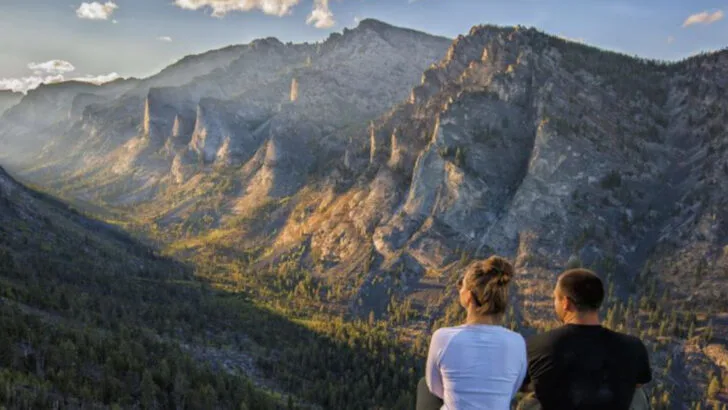Nestled in the Rocky Mountains of Montana, Bitterroot National Forest is a breathtakingly beautiful landscape that is often compared to the majestic Yosemite National Park. Known as the ‘Yosemite of Montana,’ this hidden gem offers stunning vistas, diverse wildlife, and endless opportunities for outdoor exploration. From hiking the rugged trails to enjoying the serene lakes, the Bitterroot National Forest is an adventurer’s paradise. Unlike its more famous counterparts, it remains a secret treasure waiting to be discovered by those who seek solitude and natural beauty.
The stunning Bitterroot Mountains
Stretching along the Montana-Idaho border, the Bitterroot Mountains define the forest’s dramatic landscape. These rugged peaks are shaped by glaciers and time, forming steep granite ridges, snow-capped summits, and high basins that come alive with wildflowers each summer.
They offer the kind of alpine grandeur you’d expect in the Sierra Nevada—but without the crowds or traffic. From any angle, the Bitterroots are breathtaking, offering endless inspiration for hikers, photographers, and anyone who loves mountain scenery.
Blodgett Canyon – Montana’s hidden Yosemite Valley
Blodgett Canyon has earned its nickname for good reason. With sheer granite walls that tower nearly 1,000 feet and a deep, glacial-carved canyon floor, it’s visually stunning and easily accessible. A well-maintained trail leads you past dramatic rock faces, quiet forests, and seasonal waterfalls.
It’s a hotspot for climbers, but also an easy day hike for families and casual adventurers. The mix of epic scale and peaceful surroundings makes Blodgett Canyon one of the forest’s most iconic and rewarding destinations.
Hundreds of miles of hiking trails
Bitterroot National Forest offers more than 1,600 miles of trails, ranging from easy riverside strolls to challenging alpine routes. The variety is one of the forest’s biggest strengths—you can choose a short loop through wildflower-filled meadows or embark on multi-day treks deep into the wilderness.
One of the most famous hikes is the Trapper Peak Trail, which climbs to the tallest summit in the Bitterroots. At over 10,000 feet, it offers a panoramic view that stretches for miles in every direction.
Pristine alpine lakes
The forest is dotted with dozens of alpine lakes, each tucked into its own quiet corner of the mountains. These lakes, like Lake Como, Bass Creek Lake, and Kidney Lake, are known for their crystal-clear waters, framed by evergreens and rocky outcrops.
They’re perfect for swimming, fishing, kayaking, or just relaxing on the shoreline. Many require a hike to reach, but the payoff is solitude and scenery that feels untouched. For those who want easy access, Lake Como also offers beaches, trails, and paddleboard rentals.
Wildlife watching without the crowds
Unlike busier national parks, Bitterroot offers the rare chance to observe wildlife in a more natural and peaceful setting. You might spot elk grazing in open meadows, moose browsing in willow thickets, or mountain goats scaling steep cliffs.
Bald eagles soar above river valleys, and black bears are occasionally seen in backcountry areas. There’s even a chance of spotting a grizzly in the deeper wilderness zones. Here, animal encounters feel wild and authentic—not crowded or commercialized.
Fly fishing paradise on the Bitterroot River
The Bitterroot River winds through the valley like a lifeline, attracting anglers from across the country. Known for its healthy trout populations, including rainbow, cutthroat, and brown trout, the river is especially popular during the summer hatches.
With easy public access points, low fishing pressure, and beautiful surroundings, it’s ideal for both beginners and seasoned fly fishers. Casting a line here is as much about the experience as the catch.
Wilderness areas galore
If you’re looking for real solitude, the forest’s wilderness areas deliver. The Selway-Bitterroot Wilderness and Anaconda-Pintler Wilderness together offer over 1.5 million acres of remote, undeveloped land.
These areas are accessible only by foot or horseback and are laced with rugged trails, high passes, and pristine alpine valleys. They’re perfect for backpackers seeking multi-day escapes, where star-filled nights and absolute quiet are part of the adventure.
Lake Como – the go-to recreation hub
Lake Como is the forest’s most popular outdoor playground—and for good reason. It’s easily accessible, family-friendly, and packed with activities. You’ll find a sandy beach, paddleboard and kayak rentals, campgrounds, and a 7-mile trail that loops around the shoreline.
It’s a favorite for swimming, boating, hiking, and relaxing in the summer sun. Whether you’re planning a picnic or a weekend camping trip, Lake Como is a great home base for exploring the area.
Epic backcountry camping and stargazing
If you crave a night under the stars, Bitterroot National Forest offers some of the best backcountry camping in the Rockies. With almost no light pollution, the night skies are brilliant—perfect for stargazing or astrophotography.
Whether you’re in a remote alpine basin or tucked beside a quiet stream, the experience is deeply immersive. The silence, the fresh air, and the sheer remoteness create unforgettable nights for anyone willing to hike a little off the beaten path.
Accessible from charming mountain towns
Despite its wild character, Bitterroot is surprisingly easy to reach. Towns like Hamilton, Darby, and Stevensville serve as welcoming gateways to the forest.
They offer cozy lodging, local restaurants, seasonal farmers markets, and friendly communities. Some spots have even been used as filming locations for the TV series Yellowstone.
These towns let you enjoy the comforts of civilization while still having quick access to trailheads, rivers, and mountain views.
A four-season destination
Bitterroot’s beauty changes with the seasons, making it a year-round destination. Summer is perfect for hiking, paddling, and fishing. Fall brings a golden glow as larch trees turn vibrant yellow across the hillsides.
Winter transforms the forest into a quiet snow-covered escape, with opportunities for cross-country skiing, snowshoeing, and wildlife tracking.
Spring offers roaring waterfalls and the return of wildflowers. No matter when you visit, the forest offers something spectacular.

